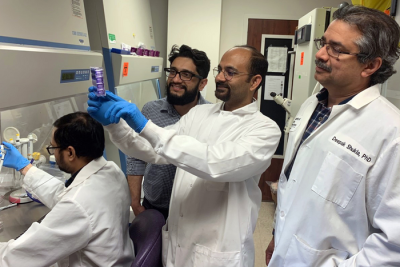
In their lab, UIC researchers (left to right) Hemant Borase, Tejabhiram Yadavalli, Chandrashekhar Patil and Deepak Shukla. Photo courtesy of Deepak Shukla.
A new study on herpes infections of the eye from University of Illinois Chicago researchers helps shed light on the question of viral reinfections by identifying a key protein involved in viral reinfections that could be targeted by antiviral drugs.
The UIC team examined how the heparanase protein, which is present in all our cells, affects reinfection from the herpes simplex virus type 1 in mice. They found that inhibiting heparanase activity can protect the eyes from being reinfected. Mice that had their heparanase protein blocked showed no signs of cloudiness in their corneas after a second infection, as compared with mice with normal heparanase, whose corneas showed significant signs of reinfection.
Additionally, the researchers found that when the protein is activated due to infection, the immune system may exacerbate the symptoms during a second infection. The study, published recently in Science Advances, also discovered that when heparanase is malfunctioning, the virus is more likely to cause disease in individuals previously infected with the virus.
Taken together, the findings suggest that inhibiting the activity of the heparanase protein can be an effective way to prevent herpes simplex virus type 1 reinfection, potentially leading to a breakthrough in preventing the recurrence of these infections.